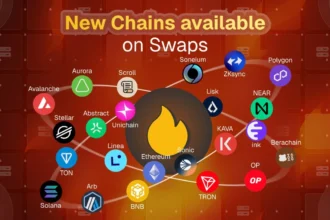Exchanges vs HOT Omni Protocol
As cryptocurrency adoption grows, many users still rely heavily on centralized exchanges for handling their USDT balances and cross-chain transfers. While convenient, this approach is not without significant risks. The HOT Omni Protocol emerges as a safer, decentralized solution that maintains user control while offering fast and affordable cross-chain token transfers.
Centralized Exchanges: Convenience at a Cost
Exchanges simplify asset management by abstracting away blockchain-specific complexities. Users deposit USDT to a given address, and the exchange reflects the balance in their internal database. Benefits include:
- No network fees for internal transfers
- Fast transactions
- Pooled liquidity
However, these advantages come with drawbacks:
- Security Risks: Centralized platforms are frequent targets of hacks and insider manipulation.
- Custodianship: Users surrender full control of their funds.
- Lack of Transparency: Fund misuse, such as risky leveraged trading by subsidiaries, can lead to unexpected losses.
The HOT Omni Protocol: A Decentralized Exchange Alternative
To eliminate the drawbacks of centralized exchanges while retaining cross-chain efficiency, the HOT Wallet ecosystem introduces the HOT Omni Protocol. This protocol offers decentralized balance sheet abstraction without sacrificing security.
What Is the HOT Omni Protocol?
The HOT Omni Protocol bridges liquidity contracts with abstract token storage, similar to a centralized exchange, but through smart contracts that are fully audited and secured on the blockchain.
- Liquidity Contracts act as on-ramps and off-ramps (think of them as multi-currency ATMs).
- Abstract Vaults function as your decentralized personal bank account, ensuring your assets are safe and sanctions-free.
How It Works: Simplified Analogy
Imagine you deposit money at an ATM (liquidity contract). You get a receipt and head to a secure bureau (HOT MPC) where inspectors (nodes) independently verify it. Once there’s consensus, your decentralized vault (smart contract) is credited.
For withdrawals, the reverse happens: The bureau validates your withdrawal rights, issues a receipt, and you retrieve your funds from an ATM in the network of your choosing.
The Role of HOT MPC Protocol
The HOT MPC Protocol functions as the security layer or the “bureau.” It is a network of independent nodes that:
- Verify transactions
- Generate secure multi-signature approvals
- Prevent fraud through decentralized consensus
This setup ensures that no single dishonest actor can compromise your funds. If one node misbehaves, it is eliminated from the network and the rest of the nodes earn additional rewards for maintaining integrity.
Benefits of the HOT Omni Protocol
- Non-Custodial Storage: Your assets are always under your control.
- Cross-Chain Efficiency: Seamless USDT transfers across networks without needing to withdraw to the base blockchain.
- Minimal Fees: Transfers within the HOT network cost a fraction of a cent.
- Decentralization: No single point of failure.
- High Speed: Transactions complete almost instantly.
Real-World Applications
- Mass Token Distributions: Enables efficient and low-cost token airdrops.
- Decentralized Exchange Integration: Acts as the backbone for peer-to-peer trading.
- Token Transfers: Users can send USDT within HOT and allow recipients to choose their withdrawal network based on fee efficiency.
The Bridge Architecture
This is how HOT Wallet bridges work:
- Funds enter through a liquidity contract on the origin chain.
- HOT MPC nodes validate and approve the transaction.
- The abstract vault reflects your updated balance.
- Withdrawals trigger the reverse process to the desired chain.
All this happens while keeping the HOT Wallet functions “cold,” meaning they remain non-custodial and under user control at all times.
Frequently Asked Questions (FAQs)
1. What makes HOT Omni Protocol better than traditional exchanges?
It offers decentralized, secure, and non-custodial token storage and transfer without the risks associated with centralized exchanges.
2. Is HOT Omni Protocol safe?
Yes. It uses HOT MPC for decentralized validation, making it highly secure and transparent.
3. Can I transfer USDT across different blockchains using HOT Wallet?
Absolutely. You can send USDT across chains with minimal fees and full control.
4. Do I need to return tokens to a specific network for withdrawal?
No. The recipient can choose which network to withdraw to, enhancing flexibility.
5. How does HOT MPC prevent fraud?
It relies on a decentralized network of nodes for consensus, so any malicious node can be detected and removed.
6. Is the HOT Wallet custodial?
No, it’s non-custodial. Your tokens are always under your control.
7. What fees are involved?
HOT network fees are extremely low, often less than a cent.
8. Can I integrate HOT Omni Protocol in my project?
Yes, developers can leverage the protocol for secure and scalable token movement and storage.
Disclaimer
This article is for informational purposes only and does not constitute financial or investment advice. Cryptocurrency investments carry risk. Always conduct your own research and consult with a professional before making financial decisions. The HOT Omni Protocol is a decentralized solution that may require technical knowledge to fully utilize. Ensure that you understand all functionalities and risks before interacting with the system.



